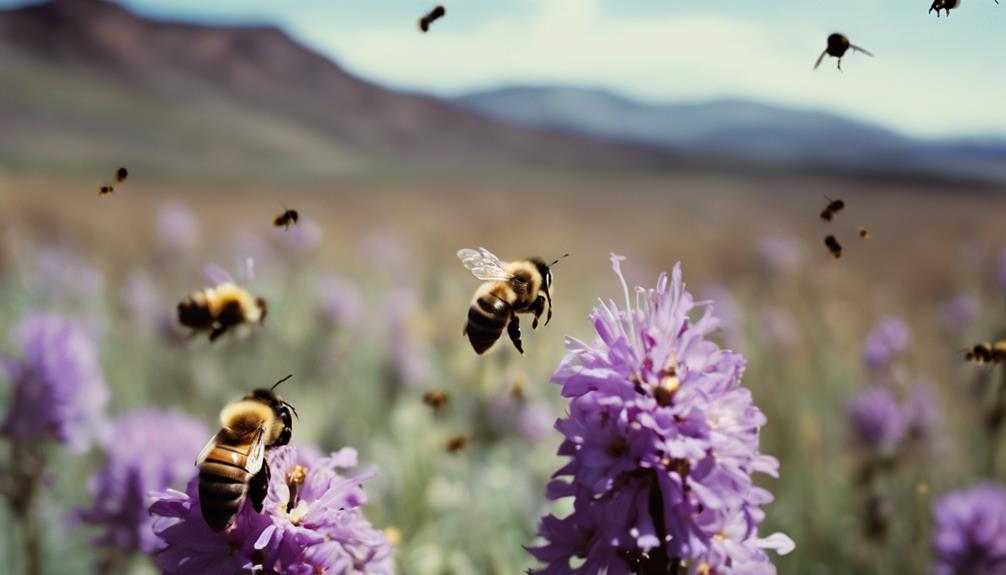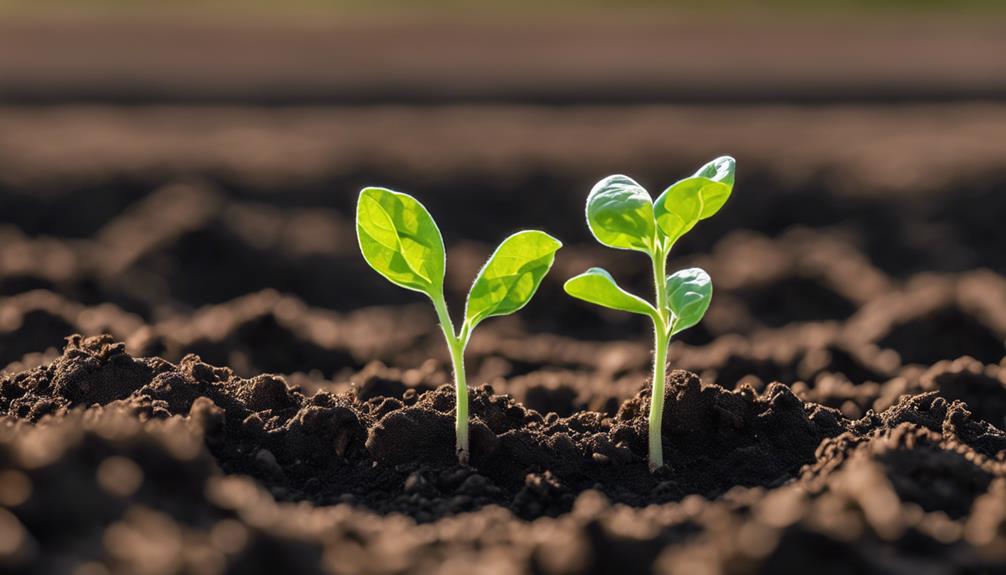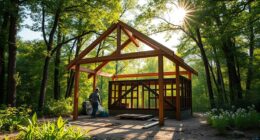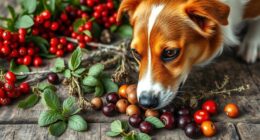Forage collards are edible for humans, offering rich vitamins A, C, and K, calcium, iron, and fiber for overall health. They're versatile, suitable for boiling, sautéing, steaming, or raw consumption in salads or smoothies. Compared to kale, they have a milder flavor, hearty texture, and extended growth for continuous harvest. For best taste, harvest young leaves, blanch, and freeze for storage. Despite requiring experimentation with cooking for tenderness, forage collards are safe to eat. Consider mixing with ingredients, marinating, or massaging for improved palatability. Their surprising nutritional benefits and culinary adaptability make them a valuable diet addition.
Key Takeaways
- Forage collards are edible and offer numerous health benefits.
- They require proper cooking methods for optimal tenderness and flavor.
- Mixing with other ingredients can enhance their palatability.
- Younger leaves are milder in taste and suitable for raw consumption.
- Experimentation with cooking techniques can improve their texture.
Nutritional Benefits of Forage Collards

Discover the nutritional benefits of forage collards, packed with vitamins and minerals essential for a healthy diet. Grown for livestock consumption, forage collards offer a surprising array of nutrients when harvested for human consumption.
Years ago, farmers along County Road began cultivating these nutrient-rich greens, recognizing their potential not just for animals but also for human diets. The extended vegetative growth period of forage collards allows them to accumulate higher levels of essential vitamins A, C, and K, along with minerals like calcium and iron. This nutrient richness makes forage collards a standout choice for promoting overall health and well-being in both animals and humans.
Not only are they known for their digestibility, but they also provide a good source of fiber, supporting digestive health. With all these benefits, it's clear that forage collards are a valuable addition to any diet, offering a unique and nutrient-dense option for those seeking to enhance their nutritional intake.
Comparison to Common Leafy Greens

Forage collards, belonging to the Brassicas family, offer a unique flavor profile and texture when compared to common leafy greens like kale and spinach.
Unlike the more delicate leaves of spinach, forage collards have a robust texture that holds up well in cooking. While kale is known for its slightly bitter taste, forage collards provide a milder flavor that can appeal to a broader range of palates.
Additionally, the extended vegetative growth period of forage collards allows for continuous harvest of large, nutritious leaves, making them a versatile option for various dishes.
Compared to spinach, forage collards are heartier and can withstand longer cooking times without becoming overly wilted.
When considering leafy greens for your meals, the unique characteristics of forage collards can add depth and complexity to your culinary creations, offering a fresh twist on traditional recipes.
Cooking Methods for Forage Collards

When cooking forage collards, boiling them can help achieve tenderness, while sautéing with garlic and olive oil provides a quick and flavorful option.
Steaming forage collards is a great way to retain their nutrients while enhancing their natural taste.
Experiment with these cooking methods to enjoy the unique flavor and health benefits of forage collards in your meals.
Boiling for Tenderness
To achieve tenderness when cooking forage collards, consider boiling them until they reach the desired softness. Boiling forage collards is a common method used to make them palatable for human consumption.
By cooking these greens in boiling water for a longer period, you can break down their tough fibers and enhance their flavor, resulting in a softer texture and milder taste. This process helps reveal their nutritional benefits, making them a delicious addition to various dishes.
Boiling forage collards allows you to enjoy their unique taste while incorporating them into your diet in a healthy way. Remember, the key to achieving the perfect tenderness is to monitor the cooking time carefully, ensuring that the collards are neither undercooked nor overcooked.
Experiment with different cooking times to find the ideal level of tenderness that suits your palate.
Saute for Quick Cooking
Consider sautéing forage collards in a pan with olive oil and seasonings for a quick and flavorful cooking method. Sautéing forage collards is a popular way to enjoy these nutritious greens while preserving their taste and texture. By cooking them quickly over medium-high heat, you can retain the nutritional value of forage collards and create a tender dish that pairs well with various meals.
The mild and slightly sweet flavor of sautéed forage collards makes them a versatile ingredient in different recipes. To enhance the taste, consider adding seasonings like garlic, lemon juice, red pepper flakes, or soy sauce. These flavor additions can elevate the dish and make it even more enjoyable to eat.
Sautéing forage collards not only offers a delicious outcome but also allows for a quick cooking process, making it a convenient option for busy days. Whether as a side dish or part of a main course, sautéed forage collards can be a delightful addition to your culinary repertoire.
Steam for Nutrient Retention
To further enhance the nutritional value of forage collards while maintaining their flavor, steaming is a recommended cooking method that effectively preserves their nutrients and softens their tough leaves.
Steaming forage collards is a popular choice because it helps safeguard the vitamins and minerals present in these leafy greens. By steaming them, you guarantee that the nutrients remain intact, making forage collards a healthy addition to your diet.
Additionally, steaming helps break down the fibrous texture of forage collards, resulting in a more pleasant eating experience. This cooking method not only maintains the nutritional benefits of forage collards but also enhances their unique taste.
Raw Consumption Tips

When incorporating raw forage collards into your diet, start by choosing younger leaves for a milder flavor.
Raw forage collards, though tougher and more bitter than traditional collard greens, can be consumed by humans in moderation.
To enhance their taste and texture, consider cooking or blanching them before consumption.
If you prefer to enjoy them raw, incorporating forage collards into salads or smoothies can provide a nutrient boost. However, due to their bitter taste, you may need to add additional seasoning or dressing for palatability.
Experimenting with different preparation methods, such as marinating or massaging raw forage collards with olive oil and lemon juice, can also help enhance their flavor.
Remember to harvest younger leaves for a milder taste and explore various ways to incorporate raw forage collards into your meals to enjoy their potential health benefits.
Potential Health Benefits

Forage collards pack a powerful punch of essential nutrients like vitamins A, C, and K, along with calcium, fiber, and antioxidants.
Whether you enjoy them raw in salads or cooked in hearty dishes, these leafy greens offer a wide range of health benefits.
Including forage collards in your diet can support immune function, bone health, digestion, and more, making them a valuable addition to your meals.
Nutritional Value of Forage Collards
With their abundance of essential vitamins and minerals, forage collards offer numerous potential health benefits for those who consume them. These leafy greens are packed with nutrients like vitamin C, known for its immune-boosting properties, vitamin K, important for bone health, and calcium, essential for strong bones and teeth.
Incorporating forage collards into your diet can contribute to improved immune function, better bone density, and enhanced heart health due to their nutrient content. The deep taproot of forage collards allows them to absorb nutrients effectively from the soil, making them a nutrient-dense option for human consumption.
While primarily grown as livestock forage, forage collards can also be enjoyed by humans in dishes like salads, soups, and stir-fries, providing a flavorful and nutritious addition to your meals. Consider adding these versatile and nutrient-rich greens to your diet for a healthful boost.
Cooking Methods for Forage Collards
To harness the full potential health benefits of forage collards, exploring various cooking methods can elevate both the flavor and nutrient profile of these nutrient-rich greens.
When cooking forage collards, consider steaming, sautéing, or incorporating them into soups and stews to retain their vitamins and minerals while enhancing their taste.
Steaming forage collards can help preserve their nutrients, while sautéing with garlic and olive oil can add a savory dimension to their flavor.
Additionally, using forage collards in soups and stews allows them to impart their nutritional benefits into the broth, creating a wholesome meal.
Experimenting with different cooking techniques can make forage collards a versatile and delicious addition to your diet, ensuring you get the most out of their vitamin A, C, and K content, as well as essential minerals like calcium and manganese.
Forage Collards in Salads

Consider incorporating nutrient-rich forage collards into your salads for a healthy boost of vitamins and minerals. Forage collards, belonging to the Brassicas family, aren't only edible but also highly nutritious, making them an excellent choice for salad greens.
Their extended growth period allows for a sustainable and abundant supply of fresh leaves for your salads. The deep taproot of forage collards aids in absorbing essential nutrients, resulting in nutrient-dense leaves that can enhance the nutritional value of your salads.
When added to salads, these collards offer a unique and hearty flavor profile, bringing a fresh twist to your dish. Their versatility in texture and taste makes them a great option for those looking to incorporate homegrown greens into their diet.
Incorporating Into Smoothies

Forage collards can be a valuable addition to your smoothies, providing a nutrient-packed boost to your daily intake. Their rich vitamins and minerals can enhance the nutritional value of your blended drinks.
Smoothie Boost: Forage Collards
Incorporate forage collards into your smoothies for a nutrient-packed boost. These leafy greens aren't only edible but also offer a wealth of vitamins like A, C, and K, making them a healthy addition to your daily smoothie routine.
Here are a few reasons why forage collards can be a game-changer for your smoothie game:
- Rich in Vitamins: Forage collards are packed with essential vitamins that can help support your overall health and well-being.
- Green Goodness: The large, nutritious leaves of forage collards add a vibrant green color to your smoothies, signaling a high content of beneficial nutrients.
- Sustainable Nutrition: With their sustainable growth pattern and nutrient-rich profile, forage collards provide a reliable source of goodness for your smoothies.
Nutrient-Packed Additions
Enhance your smoothies' nutritional value by blending nutrient-dense forage collards into your recipes for a vibrant green color and a fresh, earthy flavor. Forage collards are packed with essential vitamins like vitamin A, vitamin K, vitamin C, and folate, making them a powerhouse addition to your daily smoothie routine.
By incorporating these leafy greens into your blends, you can increase your fiber intake, promote digestive health, and boost your overall well-being with their rich nutrient profile. The earthy taste of forage collards complements various fruits and vegetables, allowing you to experiment with new flavor combinations while reaping the health benefits they offer.
Adding forage collards to your smoothies isn't only a creative way to enjoy their nutritional perks but also a simple and effective method to elevate the nutrient content of your daily diet. Start blending and savor the goodness of forage collards in each delicious sip of your revitalizing smoothie concoctions.
Forage Collards Recipes to Try

Explore delicious recipes that showcase the versatility and flavor of forage collards in your culinary repertoire. Forage collards aren't only edible but also highly nutritious, making them a great addition to various dishes. Consider trying a recipe like chickpea collard wraps to incorporate these nutrient-packed greens into your meals.
Here are some additional recipes to help you make the most of forage collards:
- Collard Green Salad: Combine thinly sliced forage collards with cherry tomatoes, cucumbers, feta cheese, and a zesty lemon vinaigrette for an invigorating and healthy salad option.
- Collard Green Soup: Simmer forage collards with vegetable broth, onions, garlic, and white beans for a hearty and comforting soup that's perfect for colder days.
- Collard Green Stir-Fry: Stir-fry forage collards with bell peppers, tofu, and a savory soy sauce-based sauce for a quick and flavorful dish that can be served over rice or noodles.
Incorporating forage collards into your cooking not only adds a nutritional boost but also introduces a delicious earthy flavor to your meals.
Harvesting and Storing Forage Collards

Consider harvesting forage collards for human consumption when the leaves are young and tender to guarantee excellent flavor and nutrient content.
To preserve the freshness and nutritional value of forage collards, blanching and freezing the leaves are recommended storage methods. By blanching the collard leaves briefly in boiling water and then immediately cooling them in ice water, you can lock in their vibrant color, flavor, and essential nutrients. Once blanched, the leaves can be frozen in airtight containers for future use.
When incorporating forage collards into your meals, remember that they can be chopped and processed for easy integration into various recipes such as soups, stews, and stir-fries. Pre-portioning and freezing forage collards allow for convenient access to this nutritious green throughout the year, ensuring you always have a healthy ingredient on hand for your culinary creations.
Explore the versatility of forage collards in your cooking by trying out different recipes beyond the traditional uses, adding a nutritious boost to your meals.
Considerations for Human Consumption

When consuming forage collards, make sure to properly wash and cook to guarantee safety and palatability.
Forage collards, although primarily grown for livestock, are safe for human consumption. However, they may lack the tenderness and flavor of traditional collard greens.
To enjoy forage collards, consider the following:
- Experiment with different cooking methods like sautéing, steaming, or braising to enhance their taste and texture.
- Mix forage collards with other ingredients in dishes like casseroles or pasta to balance out their fibrous nature.
- Consider marinating or massaging the leaves to help break down tough fibers and improve overall palatability.
While some may find forage collards too fibrous or tough for their liking, with proper preparation and creative cooking techniques, they can be a nutritious addition to your diet.
Remember to explore various recipes and cooking styles to find what suits your taste preferences best.
Frequently Asked Questions
Are Forage Collards Edible for Humans?
Yes, forage collards are indeed edible for humans. They belong to the Brassicas family, offering great nutritional value. Despite being primarily grown for livestock, these nutritious greens can be a healthy addition to your diet. In fact, their leaves are rich in vitamins A, C, and K, as well as minerals like calcium and iron, making them a nutrient-dense choice for meals. While they may have a slightly tougher texture compared to varieties bred specifically for human consumption, they can still be enjoyed sautéed, steamed, or added to soups and stews. So, it’s clear that forage collards are edible and can offer a wide range of health benefits when incorporated into your diet. Additionally, the edibility of forage collards makes them a versatile option for those looking to diversify their intake of leafy greens. Though they may require a bit more cooking time to soften their fibrous texture, their flavor is robust and earthy, pairing well with various seasonings and ingredients. By experimenting with different cooking methods, you can easily incorporate forage collards into your meals while enjoying their health benefits.
What Is Forage Collards?
Imagine forage collards as leafy powerhouses, like a bustling city of nutrients underground and a vibrant green metropolis above. These plants, with their deep roots and abundant leaves, thrive in grazing systems, benefiting both livestock and the land.
Why Did Slaves Eat Collard Greens?
You ate collard greens as a slave for their nutrition, affordability, and flavor. Cooked with scraps, they provided essential nutrients like vitamin A and C. Post-emancipation, they symbolized resilience and community, continuing as a cherished dish today.
What Are the Side Effects of Collard Greens?
When you consume collard greens, be mindful of potential side effects like gas, bloating, and kidney stone formation due to their high fiber and oxalate content. Cooking them can help reduce these risks, so enjoy them in moderation.
Conclusion
To sum up, forage collards are indeed edible for humans and offer a range of nutritional benefits.
One example is a study conducted by nutritionists showing that incorporating forage collards into a balanced diet can lead to improved digestion and increased energy levels.
With proper preparation and cooking methods, forage collards can be a tasty and nutritious addition to your meals.
So go ahead and give them a try!










